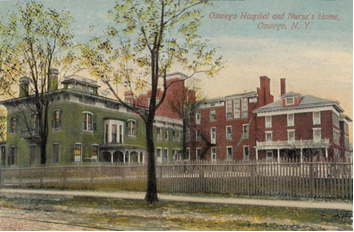Early Oswego County History

More than three centuries ago Samuel Champlain, with an army of Indians, came to the section which is now Oswego County and battled with the Six Nations, only to be routed. In 1654 Le Moyne, Jesuit priest, with fifty men, visited this same territory, and stayed for some years. Count Frontenac made it his military base in his fights with the Indians from 1690 to 1697. Such was the record of the French.
English traders located in the area in 1722, and two years later, planned, with the approval of Governor Burnet, to build a fort. This project, despite the remonstrances of the French, was carried out in 1727. The trading post became the center of control for the region; with permanent settlers, additional fortifications, it soon became a town of note. Its name was that of the river around which it was built, Oswego, from the Indian Oshwakee, “the flowing out of the waters.”
When there was an agitation for a new county, and one was erected from Oneida and Onondaga on March 1, 1816, no more appropriate title for it could be found than that of the river and the main village. Strife came over the location of the shiretown, and the committee appointed to decide on the place begged the question by naming two county seats, Oswego and Pulaski. The county, with a population of only six or seven thousand, felt too poor to erect two courthouses, so for 45 years the business of the county was carried on in private houses, alternating, three years to each place.
Between the erection of the fort by the lake and the erection of the county, war had troubled the region. The increasing friction with the French caused preparations to be made for the conflict which must come. A massive fort (Ontario) was built on the east side of the Oswego River and another (Fort George) on the opposite heights. Vessels, the first built by the English, were launched on Lake Ontario the same year, 1755. With the next year hostilities opened. In August of 1756 General Montcalm captured the two forts, with 1,700 prisoners, and the whole area was razed, leaving Oswego desolation.
During the Revolution there was much passing to and fro through the county, with some desperate engagements. It is a noteworthy fact that the last military movement of the Revolution was an attempt, by troops sent by General Washington, to retake the forts on Lake Ontario. Fort Ontario was the last frontier post to be surrendered by the English, July 15, 1796. This event was celebrated by the city of Oswego in 1896. The fort was partly torn down in 1903 and two years later replaced by a more modern structure.
The years succeeding the end of the Revolution saw the adjustment of land titles. With the Indian, French and English grants and sales, no title was worth much. Realizing that, after all, the Indian had the first and real right to the territory; in 1784 a treaty made with the “Six Nations” secured to them their possessions. Four years later a commission was appointed to purchase from the tribes their lands. Most of the county was ceded except small areas. In 1782 a tract running along the Oswego River was set aside for soldier bounties, and was so quickly snapped up by the New York soldiers entitled to it, those two days after issuing an advertisement for the claimants to appear, the commissioner distributed the land, July 5, 1790. The above is the account of the origin of the “Military tract” which comprised all the land west of the Oswego River.
Colonization began quickly after this distribution. The first white settler in the county was Oliver Stevens, who located at Fort Brewerton in 1789, and kept a tavern for the reception of the passing trader. At the close of the eighteenth century, there were many settlements scattered through the area. The principal ones were those at Redfield, Constantia, Mexico; a few folk resided at Oswego, and Union.

